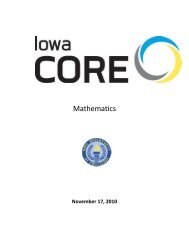The Arc's Self-Determination Scale: Procedural Guidelines
The Arc's Self-Determination Scale: Procedural Guidelines
The Arc's Self-Determination Scale: Procedural Guidelines
Create successful ePaper yourself
Turn your PDF publications into a flip-book with our unique Google optimized e-Paper software.
alternative ways in which self-determination could be<br />
conceptualized.<br />
<strong>The</strong>re is a temptation to define self-determination in terms of<br />
specific behaviors like problem-solving, assertiveness or decisionmaking.<br />
This temptation is strong because the image of a selfdetermined<br />
person conjured up by most people is that of a<br />
successful person using such behaviors. However, after further<br />
reflection it becomes evident that self-determination cannot be<br />
defined as a set of behaviors for two reasons: (1) any behavior can<br />
be self-determined; and (2) both the occurrence and non-occurence<br />
of a behavior can be self-determined.<br />
In the first instance, although there are behaviors that are<br />
typically viewed as self-determined (making choices, problemsolving,<br />
self-advocacy, etc), when one attempts to compile a list of<br />
behaviors that could “define” self-determination, that list will grow<br />
exponentially to encompass virtually any behavior in a person’s<br />
repertoire. For example, speaking up for yourself is generally<br />
identified as a self-determined action, and in most cases it is.<br />
However, if “speaking up for yourself” is a defining variable of<br />
self-determination, then people who cannot speak are, a priori,<br />
eliminated from being self-determined. One might then point out<br />
that it is not the act of “speaking” itself that is self-determined, but<br />
the intention of that act. As such, we can expand the list to include<br />
“speaking up for yourself”, “using sign language to communicate<br />
your wants”, “using [a specific augmentative communication<br />
device] to communicate”, and so forth. <strong>The</strong> list quickly expands to<br />
the point of being unwieldy and cumbersome.<br />
One solution to this problem is to broaden the behavior(s)<br />
identified as defining self-determination. So, for example, instead<br />
of “speaking up for oneself” as the defining variable, this could be<br />
rewritten as “communicating for oneself” as the behavior of note.<br />
However, this is an unsatisfactory solution for several reasons.<br />
First, while some behaviors might be amenable to such summation,<br />
others that could clearly be interpreted as self-determined are not.<br />
Consider a situation where two consenting adults with disabilities<br />
decide to get married. In the aftermath of this decision, they meet<br />
heavy resistance from friends, family members and professionals<br />
who predict disaster and threaten to prohibit the marriage. In<br />
response to this, the couple elopes to Nevada and they are married<br />
the next week. Is, then, “getting married” a behavior we should<br />
add to our definition? Obviously not, as many people choose to<br />
remain single or live together without getting married. What then<br />
is the broader behavior to be identified? In essence the couple was<br />
acting on a decision, exerting control over their lives and acting on<br />
preferences and dreams. None of these adequately describe why<br />
the act was self-determined, and several (e.g., exert control, act on<br />
20
















